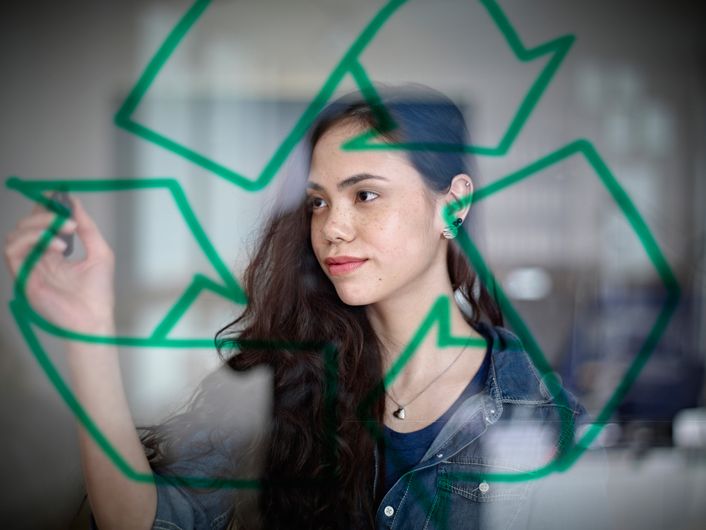Charging column strategy: making convenient progress with Audi

Audi Q4 Sportback e-tron: Power consumption (combined) in kWh/100 km: 18.9–15.6CO₂ emissions (combined) in g/km: 0CO₂ emission class: A
Audi Q4 Sportback e-tron: Power consumption (combined) in kWh/100 km: 18.9–15.6CO₂ emissions (combined) in g/km: 0CO₂ emission class: A
AUDI AG takes its environmental responsibilities very seriously and wants to become the leading provider of carbon-neutral mobility. Switching its product range to electric vehicles is not enough. Other powerful levers are a comprehensive range of charging options and the type of electricity that e-vehicles can “fill up with” at charging points. Fossil fuels are still used to some extent to generate this electricity.
Audi wants to change that. Its aim is for the amount of electricity generated from renewable sources to continue to rise along with further increases in the number of electric cars manufactured.
„More than ever before, it isn’t just the product that matters, but the entire ecosystem.“
To charge their cars at home, Audi drivers can use the renewable electricity offered by Elli (Electric Life), part of the Volkswagen Group. And for charging on the road, Audi is also now consistently pressing ahead with the expansion of a close-meshed charging infrastructure – above all through the IONITY joint venture of which Volkswagen is a part with its brands Porsche and Audi.
IONITY campaign strengthens charging offer

With approximately 1,500 fast charging points, IONITY already provides Europe’s biggest network of high-power charging points (HPCs) 350 kW charging power – currently the highest possible technically- to drivers of electric vehicles.
IONITY now wants to provide around 5,000 more of these ultra-fast HPC points throughout Europe by 2025. Maximum charging speeds should then be available not only along freeways but also on busy highways and near big cities. And the same will apply to these as to all charging points in the IONITY network: they will always deliver 100 percent green energy.
Audi Q4 Sportback e-tron: Power consumption (combined) in kWh/100 km: 18.9–15.6CO₂ emissions (combined) in g/km: 0CO₂ emission class: A
Audi Q4 Sportback e-tron: Power consumption (combined) in kWh/100 km: 18.9–15.6CO₂ emissions (combined) in g/km: 0CO₂ emission class: A
Thanks to the IONITY campaign, however, the number of European charging sites will also increase significantly – from the current 400 to more than 1,000. New locations will be designed right from the start for six to twelve charging points, thus significantly reducing the possible waiting time for users. But the IONITY joint venture will also expand existing sites. It has acquired additional land to create covered charging stations and to make the waiting time as comfortable and convenient as possible for drivers with new cafes, snack bars or restaurants as well as shops. Approximately €700 million is being invested in implementing this flagship concept.
Charging without RFID card or app
The forward-looking expansion of the charging network will also increase the availability of the e-tron Charging Service (eCS), which is offered at IONITY charging points. Drivers already have access to more than 280,000 charging points in 26 European countries through Audi’s own charging service and benefit from preferential terms.
In addition, with Audi convenient charging is now possible without an RFID (radio frequency identification) card or app: thanks to Plug & Charge (‘PnC’ for short), drivers of a PnC-enabled model from the Audi e-tron range (Audi e-tron 50/55/S incl. Sportback derivatives with production date after calendar week 48/2021) can be automatically authenticated at compatible IONITY charging columns as soon as the charging cable is connected to their vehicle. Then the charging process starts.
Audi e-tron Sportback S line 55 quattro: Power consumption (combined) in kWh/100 km: 23.9–23.9CO₂ emissions (combined) in g/km: 0CO₂ emission class: A
Audi e-tron Sportback S line 55 quattro: Power consumption (combined) in kWh/100 km: 23.9–23.9CO₂ emissions (combined) in g/km: 0CO₂ emission class: A
„With its focus on advancing and improving the charging network offering, IONITY’s massive expansion will play a key role in making electric vehicles more attractive.“
With its commitment, Audi is underlining its claim to offer customers a convenient electric driving experience.

Audi RS e-tron GT: Power consumption (combined) in kWh/100 km: 21.1–18.4CO₂ emissions (combined) in g/km: 0CO₂ emission class: A
Audi RS e-tron GT: Power consumption (combined) in kWh/100 km: 21.1–18.4CO₂ emissions (combined) in g/km: 0CO₂ emission class: A



.jpg?imwidth=706&imdensity=1)